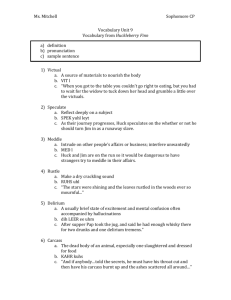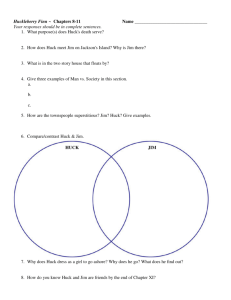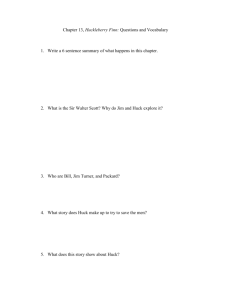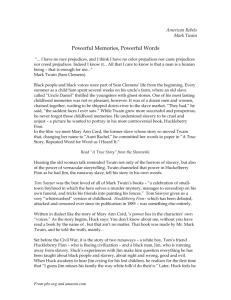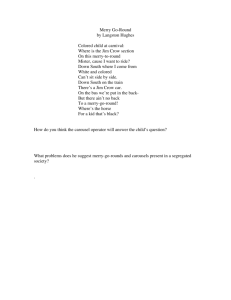Huckleberry Finn Background Powerpoint
advertisement
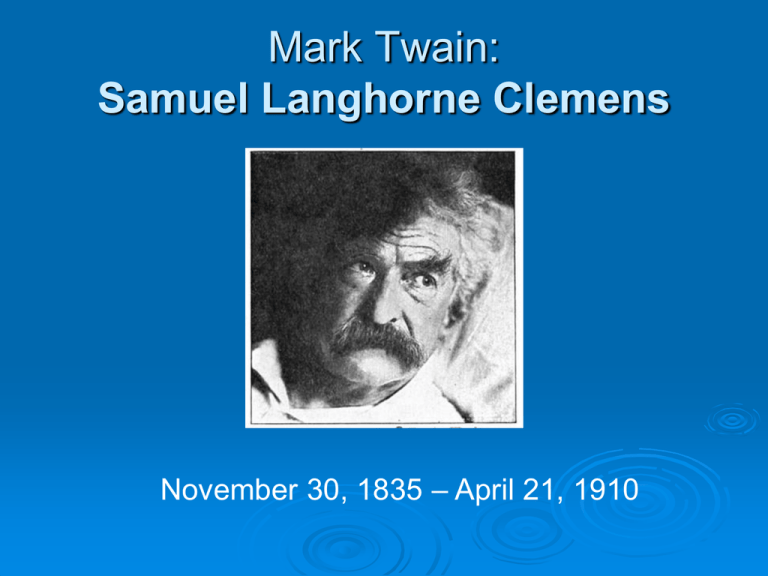
Mark Twain: Samuel Langhorne Clemens November 30, 1835 – April 21, 1910 Over 15 million copies of Huck Finn have been sold. The US has about 40 editions in print. It has been read in English, Chinese, Japanese, Russian, Hebrew, and practically every other language on the globe. How historical events influenced Twain’s writing: The Missouri Compromise Samuel Clemens’ childhood Jim Crow Laws Abolitionists Fugitive Slave Laws Minstrel Shows Looking for Cairo The Missouri Compromise The Compromise of 1850 The setting of the novel is in Missouri. Huck and a runaway slave, Jim, flee to freedom on the Mississippi River. Their destination is the Ohio River to go North. QUESTION: According to what you read on the link and the map, why would going north benefit them? Twain’s Home Town Author’s Background Mark Twain Biography - Biography.com QUESTION: According to the link, how does Samuel Clemens’ background affect the plot and characters of his writing? Life on the Mississippi: Twain meticulously studied 2,000 miles (3,200 km) of the Mississippi for more than two years before he received his steamboat pilot license in 1859. Jackson’s Island? Huck and Jim hide out on a small island in the middle of the Mississippi River. Perhaps Twain was inspired by what he saw on his travels up and down the river on a steamboat. Jim Crow Laws: 1865 Jim Crow Laws: the name ‘Jim Crow’ originated from Minstrel Shows. The mindset was that Whites were superior to Blacks in all important ways, including but not limited to intelligence, morality, and civilized behavior; sexual relations between Blacks and Whites would produce a mongrel race which would destroy America Jim Crow Guide Never assert or even intimate that a White person is lying. Never impute dishonorable intentions to a White person. Never suggest that a White person is from an inferior class. Never lay claim to, or overly demonstrate, superior knowledge or intelligence. Never curse a White person. Never laugh derisively at a White person. Never comment upon the appearance of a White female. How is the influence of these laws reflected in Huck Finn? Miss Watson sells Jim Huck apologizes to Jim Huck has to keep Jim tied up The king and the duke sell Jim Huck’s moral conflict Jim does everything he is told QUESTION: Do you think Twain is mocking slaves, or sympathizing? Abolitionism was a movement to end the slave trade and emancipate slaves in western Europe and the Americas. Abolitionists Go to the above link and consider: Huck has a runaway slave with him. He must decide whether or not to turn him in. He decides that he’ll just “got to hell” for being an abolitionist (Twain Chapter 31). QUESTION: Is being an abolitionist a good thing, or a bad thing? Morally? In the eyes of the law? Fugitive Slave Laws The law stated that any federal marshal who did not arrest an alleged runaway slave could be fined $1,000. People suspected of being a runaway slave could be arrested without warrant and turned over to a claimant on nothing more than his sworn testimony of ownership. A suspected black slave could not ask for a jury trial nor testify on his or her behalf. Any person aiding a runaway slave by providing shelter, food or any other form of assistance was liable to six months' imprisonment and a $1,000 fine. QUESTION: How does Twain use this law in the plot of Huck Finn? Minstrel Shows These three stock characters were among several that reappeared in minstrel shows throughout the nineteenth century. "Jim Crow" was the stereotypical carefree slave, "Mr. Tambo" a joyous musician, and "Zip Coon" a free black attempting to "put on airs" or rise above his station. The parody in minstrel shows was often savage. Minstrel shows developed in the 1840’s, peaked after the Civil War and remained popular into the early 1900s. Minstrelsy was a product of its time, the only entertainment form born out of blind bigotry . How is Jim’s character similar to the Minstrel Show Characters? Jim is illiterate and superstitious Jim is gullible and easily fooled Jim does everything that he is told Jim misses his family and, ironically, wants to buy them back Jim cares deeply for Huck QUESTION: Through the characterization of Jim, do you think that Twain is doing the same thing as the minstrel shows? Or creating sympathy? Think about it: Achieving a Purpose Setting Satire Irony Characters Plot Themes Motifs Symbols Dialogue Jim Crow Laws Fugitive Slave Laws Slavery Abolitionists MS River Samuel Clemens’ early years MO Compromise Minstrel Shows Huck Finn: Context the interrelated conditions in which something exists or occurs the parts of a discourse that surround a word or passage and can throw light on its meaning QUESTION: Under what social conditions did Mark Twain write Huck Finn? How did the historical context affect his purpose?

